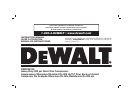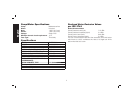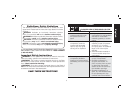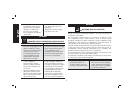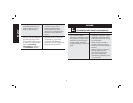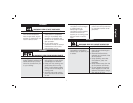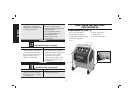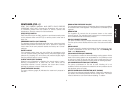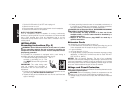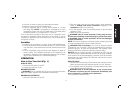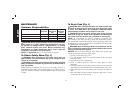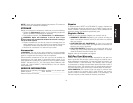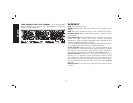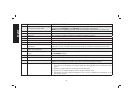
English
9
FEATURES (FIG. 1)
READ THIS OWNER’S MANUAL AND SAFETY RULES BEFORE
OPERATING YOUR UNIT. Compare the illustrations with your unit
to familiarize yourself with the location of various controls and
adjustments. Save this manual for future reference.
ON(I)/OFF(O) SWITCH
Place this switch (A) in the ON (I) position to provide automatic power
to the pressure switch and OFF (O) to remove power at the end of
each use.
PRESSURE SWITCH (NOT SHOWN)
The pressure switch automatically starts the motor when the air tank
pressure drops below the factory set “cut-in” pressure. It stops the
motor when the air tank pressure reaches the factory set “cut-out”
pressure.
SAFETY VALVE
If the pressure switch does not shut off the air compressor at its
“cut-out” pressure setting, the safety valve (F) will protect against high
pressure by “popping out” at its factory set pressure (slightly higher
than the pressure switch “cut-out” setting).
CHECK VALVE (NOT SHOWN)
When the air compressor is operating, the check valve is “open”,
allowing compressed air to enter the air tank. When the air
compressor reaches “cut-out” pressure, the check valve “closes”,
allowing air pressure to remain inside the air tank.
TANK PRESSURE GAUGE
The tank pressure gauge (B) indicates the reserve air pressure in
the tank.
REGULATED PRESSURE GAUGE
The regulated pressure gauge (C) indicates the air pressure available
at the outlet side of the regulator. This pressure is controlled by the
regulator.
REGULATOR
The regulator (D) controls the air pressure shown on the outlet
pressure gauge. Turn regulator knob clockwise to increase pressure
and counterclockwise to decrease pressure.
QUICK CONNECT BODIES
The quick connect body (E) accepts industrial quick connect plugs.
The two quick connect bodies allow the use of two tools at the same
time.
DRAIN VALVE
The drain valve (G) is located at the base of the air tank and is used
to drain condensation at the end of each use.
See Draining Air
Tank under
Maintenance.
COOLING SYSTEM (NOT SHOWN)
This compressor contains an advanced design cooling system. At the
heart of this cooling system is an engineered fan. It is perfectly normal
for this fan to blow air through the vent holes in large amounts. You
know that the cooling system is working when air is being expelled.
AIR COMPRESSOR PUMP (NOT SHOWN)
The pump compresses air into the air tank. Working air is not
available until the compressor has raised the air tank pressure above
that required at the air outlet.
MOTOR OVERLOAD PROTECTOR (NOT SHOWN)
The motor has a thermal overload protector. If the motor overheats for
any reason, the overload protector will shut off the motor. The motor
must be allowed to cool down before restarting. To restart:



